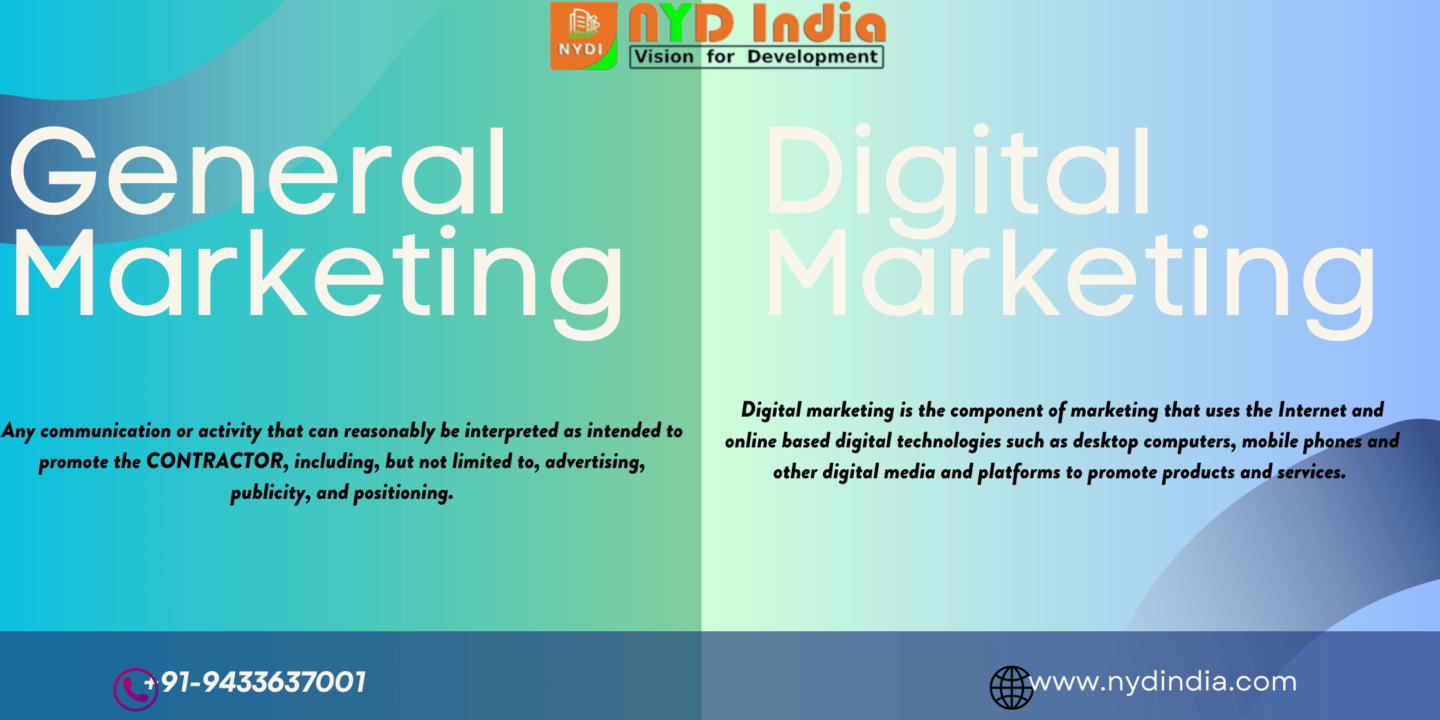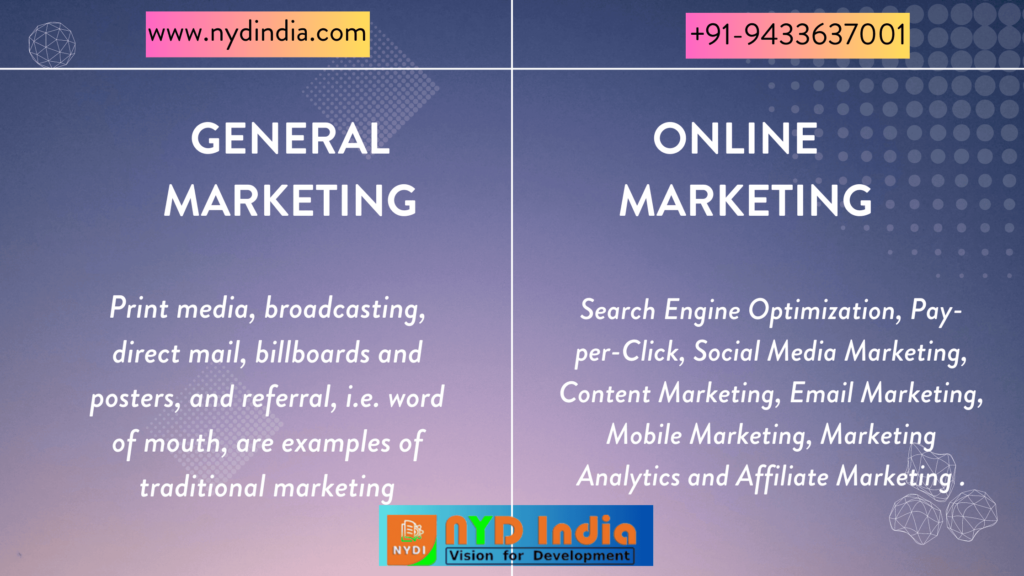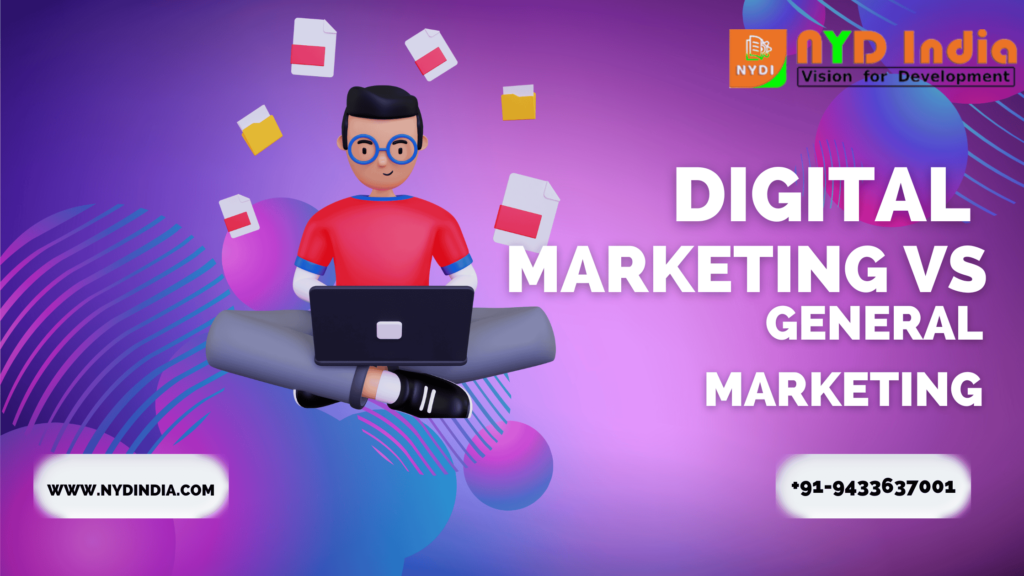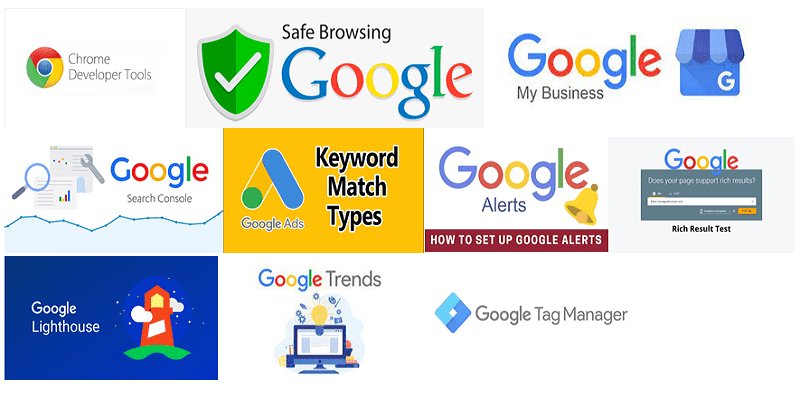
Marketing is an essential part of any business, and in today’s world, there are two main types of marketing that companies focus on: general marketing and digital marketing. General marketing refers to traditional advertising methods such as print ads, billboards, and television commercials, while digital marketing involves using digital channels such as social media, email, and search engines to reach customers. Both forms of marketing have their pros and cons, and it can be challenging to determine which one is the best for your business. In this post, we will explore the differences between general marketing and digital marketing, their benefits and drawbacks, and which one you should use for your business. Whether you’re a small business owner or an entrepreneur, understanding the differences between general marketing and digital marketing is crucial to making informed marketing decisions that will help you grow your business.
A brief overview of General Marketing and Digital Marketing
Marketing is the process of promoting and selling products or services. General marketing is promoting products or services through traditional channels like radio, TV, print ads, billboards, and direct mail. Whereas digital marketing is promoting products or services through digital channels like email marketing, social media, search engines, and mobile apps.
General marketing has been the go-to method for businesses for decades, and it does work to an extent. But it’s becoming more difficult to measure its effectiveness and reach the right audience. On the other hand, digital marketing has become increasingly popular and effective in recent years due to the fact that it is more cost-effective than traditional marketing and has the potential to reach a larger, targeted audience.
One of the biggest advantages of digital marketing is the ability to collect data and insights on customer behavior, which can be used to improve marketing efforts and increase sales. Digital marketing also allows for real-time communication with customers and the ability to personalize messages based on their preferences and behaviors.
General marketing, on the other hand, is a more passive approach and may not have the same level of targeting and personalization. However, it’s important to note that both general marketing and digital marketing have their pros and cons, and it ultimately depends on the business goals, target audience, and budget to determine which approach is best.
Advantages and disadvantages of General Marketing
General marketing is a traditional form of marketing that has been around for centuries. It encompasses all types of marketing that are not digital or online-based. This includes print, radio, television, billboards, and direct mail campaigns.
One of the main advantages of general marketing is that it can reach a wide audience. For example, a billboard on a busy highway can be seen by thousands of people every day. Similarly, a commercial during prime time television can be seen by millions of viewers. This type of advertising can create brand awareness and reach customers who may not be using the internet or social media.
However, general marketing can be expensive. It can cost thousands of dollars to produce a television commercial or print ad, and even more to get it in front of a large audience. This can be a major barrier for smaller businesses or those with a limited budget.
Another disadvantage of general marketing is that it can be difficult to track its effectiveness. It’s hard to know exactly how many people saw a billboard or heard a radio ad, and there’s no way to measure how many of those people were converted into customers.
In summary, general marketing can be effective in reaching a large audience and creating brand awareness, but it can also be expensive and difficult to measure its effectiveness.
Advantages and disadvantages of Digital Marketing
Digital marketing has become a buzzword in the last decade, with more and more businesses moving towards this new age form of marketing. However, like any other marketing strategy, digital marketing also comes with its own set of advantages and disadvantages.
Advantages of Digital Marketing:
One of the biggest advantages of digital marketing is its ability to track and measure the success of your campaigns. With tools like Google Analytics, you can track every click, impression, and conversion of your campaigns in real-time, allowing you to make changes on the go to improve your results. This is not possible with traditional marketing methods like print or TV ads.
Another major advantage of digital marketing is its reach. With billions of people now using the internet, digital platforms like social media, email, and search engines give businesses the ability to reach a wider audience than ever before. Digital marketing also offers a high level of targeting, allowing businesses to focus on specific demographics or interests, which can lead to a higher ROI.
Disadvantages of Digital Marketing:
One of the biggest disadvantages of digital marketing is its constantly changing landscape. With algorithms and best practices constantly evolving, it can be difficult for businesses to keep up with the latest trends and strategies. This can lead to wasted time and resources on campaigns that may not be effective.
Another disadvantage of digital marketing is its potential for information overload. With so many businesses vying for attention online, it can be difficult for your message to stand out. This is especially true on platforms like social media, where users are bombarded with ads and content on a daily basis.
In conclusion, digital marketing offers many advantages over traditional marketing methods, but it also comes with its own set of challenges. Businesses must carefully weigh the pros and cons of digital marketing before deciding if it is the right strategy for them.

How General Marketing and Digital Marketing differ in their approach to Customer Relationship Management (CRM)
Customer Relationship Management (CRM) is an important aspect of any marketing strategy, whether it’s general or digital marketing. However, the approach to CRM can differ greatly between the two.
General marketing often focuses on building relationships through traditional methods such as face-to-face interactions or print advertising. This involves understanding the customer’s needs and preferences and tailoring the marketing message to their interests. General marketing may also rely on customer feedback to improve products and services, and to build brand loyalty.
On the other hand, digital marketing approaches CRM in a more data-driven manner. Digital marketers use tools such as website analytics, email marketing automation, and social media monitoring to collect and analyze customer data. This data is then used to create personalized marketing messages and targeted campaigns based on the customer’s behavior, interests, and demographics.
One of the key advantages of digital marketing is the ability to track and measure customer interactions. With advanced analytics tools, digital marketers can see how customers interact with their brand across multiple channels, and use this data to improve the customer experience and build long-term relationships.
In conclusion, while both general marketing and digital marketing focus on building customer relationships, the approach to CRM differs greatly. General marketing relies on traditional methods such as customer feedback and face-to-face interactions, while digital marketing is more data-driven and uses advanced analytics to personalize marketing messages and track customer interactions.
How General Marketing and Digital Marketing differ in terms of Targeting and Segmentation
One of the biggest differences between general marketing and digital marketing is the way they approach targeting and segmentation. Traditional marketing methods, such as television and print ads, rely on broad-based targeting strategies that aim to reach as many people as possible. This often means that a lot of marketing spend is wasted on people who aren’t interested in the product or service being advertised.
Digital marketing, on the other hand, allows for much more targeted and segmented approaches. With digital marketing, businesses can use data to identify and target specific audiences based on demographics, interests, behaviors, and more. This means that marketing spend is much more effective and efficient, as it is only being directed towards people who are most likely to be interested in what is being advertised.
For example, if a business is selling baby products, they may choose to target their Facebook ads towards women aged 25-40 who have recently had a baby or are expecting one. This is a much more targeted approach than placing an ad in a general interest magazine and hoping that some of the readers are in the target audience.
Overall, digital marketing offers a much more precise way of targeting and segmenting audiences than general marketing methods. This not only saves businesses money, but also ensures that marketing efforts are much more effective in reaching the right people.
How General Marketing and Digital Marketing differ in terms of Reach and Visibility
When it comes to reach and visibility, there is a clear difference between general marketing and digital marketing. General marketing refers to traditional marketing channels, including radio, television, print, and direct mail. These channels can have a wide reach, but they are not always the most targeted. This means that you could be spending a lot of money on advertising to a large audience, but only a small portion of that audience may actually be interested in your product or service.
On the other hand, digital marketing is highly targeted and offers a higher potential for visibility. This is because digital marketing channels, such as social media, email marketing, and search engine marketing, allow you to reach your target audience directly. You can use data and analytics to understand your audience’s behavior, interests, and demographics, and then tailor your marketing messages and strategies to fit their needs and preferences.
Additionally, digital marketing offers a wider range of visibility options. For example, with search engine marketing, you can appear at the very top of search engine results pages for specific keywords related to your business. With social media marketing, you can create highly targeted ads that appear in the newsfeeds of people who have shown interest in your products or services.
In conclusion, while general marketing can have a wide reach, it may not be as effective in terms of targeting your audience. Digital marketing, on the other hand, offers a highly targeted approach that can increase visibility and engagement with your target audience.
How General Marketing and Digital Marketing differ in terms of ROI and Performance Measurement
Measuring the performance of a marketing campaign is crucial for businesses to see whether their investment has brought in a positive return. General marketing and digital marketing differ in terms of ROI and performance measurement.
General marketing campaigns, such as radio or TV ads, are more difficult to measure for ROI. It can be challenging to track how many people have seen or heard your ad and how many of those people have taken action, such as visiting your website or making a purchase.
On the other hand, digital marketing allows for much more precise performance measurement. With tools like Google Analytics, businesses can easily track how many people have visited their website, where those visitors came from, which pages they viewed, and whether they made a purchase. This type of data allows businesses to see exactly which marketing channels are bringing in the most traffic and revenue, and adjust their strategy accordingly.
In terms of ROI, digital marketing often offers a better return on investment compared to general marketing. With digital marketing, businesses can target specific audiences based on demographics, interests, and behaviors, which can lead to more qualified leads and higher conversion rates. Plus, digital marketing channels like email and social media are typically less expensive than traditional advertising methods, allowing businesses to stretch their marketing budget further.
Overall, while general marketing still has its place in the marketing mix, digital marketing offers more precise performance measurement and often a better ROI. Businesses that want to stay competitive in today’s digital age should consider incorporating digital marketing into their overall marketing strategy.
Which type of Marketing is better for your business?
Deciding which type of marketing is better for your business is not about choosing one over the other, but about finding the right balance between the two.
Traditional marketing, such as billboards, print ads, and TV commercials, can still be effective in certain industries, especially for local businesses or those targeting an older demographic. These methods have been around for decades and have a proven track record of success.
However, in today’s digital age, digital marketing has become an unavoidable aspect of any marketing strategy. With the internet being a part of almost every aspect of our lives, digital marketing provides businesses with an opportunity to reach a much larger audience.
Digital marketing includes various methods such as social media marketing, email marketing, search engine optimization, pay-per-click advertising, and content marketing. It allows businesses to target specific demographics, track and analyze their marketing efforts, and adjust their strategies accordingly.
In conclusion, the best marketing strategy for your business depends on your industry, target audience, and objectives. A balance between traditional and digital marketing can help you reach a wider audience, increase brand awareness, and ultimately drive sales.

How to create an effective Marketing campaign that combines General Marketing and Digital Marketing elements
Creating a marketing campaign that effectively combines general marketing and digital marketing elements can be a challenge, but it is certainly possible to achieve a balance that works for your business.
One key aspect of this is to understand your audience and their preferences. This will help you determine which channels to use to reach them. For example, if your target audience is older and less tech-savvy, then traditional marketing methods such as print advertising or direct mail may be more effective for reaching them. On the other hand, if your target audience is younger and more tech-savvy, then digital marketing such as social media, email marketing, and influencer marketing may be more effective.
Another important factor is consistency across all channels. Your messaging and branding should be consistent across all channels, whether it’s a billboard or an Instagram post. This helps to reinforce your brand and create a cohesive experience for the customer.
Cross-promoting between channels is also a great way to make the most of both general and digital marketing. For example, if you have a print ad running in a magazine, you could include a QR code that directs customers to your website, social media page or a landing page with a special offer. Similarly, if you have a popular social media presence, you could use it to promote your offline events or in-store promotions.
Finally, tracking and analyzing your results is essential to determine what’s working and what’s not. This will help you refine and adjust your marketing strategy as needed to ensure the best possible return on investment. With careful planning and execution, a marketing campaign that combines general marketing and digital marketing can be highly effective in reaching and engaging with your target audience.
Conclusion: The future of Marketing and the importance of a balanced approach.
In conclusion, marketing is an ever-evolving field that requires businesses to adapt and embrace new strategies for success. While traditional marketing methods have been around for decades, digital marketing has quickly become the new norm for businesses looking to expand their reach and connect with customers online.
However, it’s important to remember that a balanced approach is key to marketing success. Traditional marketing methods still hold value, especially for businesses with a local presence or those targeting an older demographic. Meanwhile, digital marketing offers endless opportunities for businesses to reach new audiences and track their performance in real-time.
The future of marketing lies in a balanced approach that combines the best of both worlds. By using a variety of marketing strategies, businesses can create a cohesive and effective marketing plan that targets customers across multiple channels. Whether it’s print ads, social media campaigns, email marketing, or SEO, a balanced approach ensures that businesses are meeting customers where they are and providing them with the information they need to make informed decisions about their product or service.
In conclusion, businesses that embrace a balanced approach to marketing will be the ones that succeed in the long run. By staying up-to-date with the latest marketing trends and strategies, businesses can create a comprehensive and effective marketing plan that delivers results and drives growth.
We hope you enjoyed our ultimate marketing showdown between general marketing and digital marketing. Both have their strengths and weaknesses, and it’s essential to understand which one will work best for your business. In today’s digital world, digital marketing may seem like the obvious choice, but traditional marketing techniques still hold value in certain industries. Ultimately, the key is to find a balance between the two that works for your business. Thank you for reading, and we hope this article helped you gain a better understanding of these two marketing approaches.

















